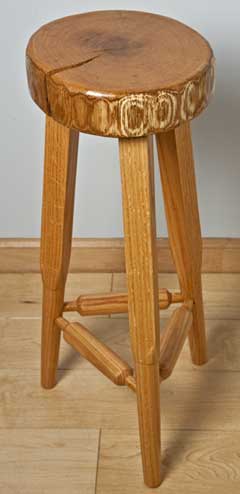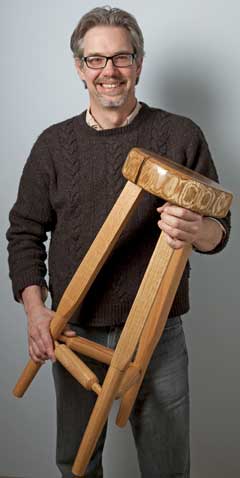 “Hey, Rob, do you think I could make some stools from these?” was the question posed to me last November while I stood next to the young man’s pickup truck in the church parking lot. A University of Minnesota student and family friend, Levi, was showing me a pile of 4-inch thick disks that he had sliced off an 18-inch diameter oak tree earlier in the week. (Levi was more than comfortable with a chain saw, as he had grown up working in his family’s apple orchard in Wisconsin.)
“Hey, Rob, do you think I could make some stools from these?” was the question posed to me last November while I stood next to the young man’s pickup truck in the church parking lot. A University of Minnesota student and family friend, Levi, was showing me a pile of 4-inch thick disks that he had sliced off an 18-inch diameter oak tree earlier in the week. (Levi was more than comfortable with a chain saw, as he had grown up working in his family’s apple orchard in Wisconsin.)
I said “Sure, just come out to the house and you can use my shop anytime … it would be fun.” Levi had many more questions about stool making that morning, and his quick understanding and curious nature was something I would really come to appreciate about him. I asked him when he would like to start, and he said that it would likely be after the beginning of the New Year – he had to finish the semester and graduate first. (I learned later that he was garnering a degree in biochemical engineering … and finishing it while he was still just 22-years old. Wow!)
Fast forward to February, and I get a text on my cell phone: “ready to make the stools!” After a good bit of text-based communications – talking on the phone is so 20th century – Levi and his oak disks were on the way to my house, and the stool building would begin.
It started out badly – my French bulldog decided to bite him on the leg, even though she had already met him before. Fortunately, Levi was gracious and the two became fast friends before the week was out.
Building went more smoothly, even though Levi was not a woodworker per se. He had had some school shop classes … but these stools were definitely going to be a step or two beyond anything he had previously done. Did I mention that he was making seven of them? This was a big project.
The great thing about being new to woodworking was that he did not feel constrained by “knowing his limits.” The design that he came up with for his stools was completely his own. Levi started out by surfacing the seats, peeling the bark off the edges and sanding them smooth. He wisely decided that three legs would be better than four – one less stretcher and, of course, with four legs it can be a bit tricky to keep one from being a bit short or long.
 Along the way, he made round tenons on the ends of square legs with a jig on the table saw and turned the lower sections of the legs and the stretchers on the lathe. He also precisely drilled holes for the legs on the bottom of the stool seats. (It turns out that engineers can just do math and figure out those angles – I usually draw really big pictures to figure it out.)
Along the way, he made round tenons on the ends of square legs with a jig on the table saw and turned the lower sections of the legs and the stretchers on the lathe. He also precisely drilled holes for the legs on the bottom of the stool seats. (It turns out that engineers can just do math and figure out those angles – I usually draw really big pictures to figure it out.)
To drill for the stretchers, he used an old Windsor chairmaking technique I showed him where you fit the legs in place, secure them in their proper relationship one to another, and then use a level piece of stock to mark the mortise locations. It worked really well.
As the days went on, I got to help him from time to time with advice (I did a little sanding on Saturday morning), but he just worked like a trouper to finish them up. In the end, he gave one of them to me, as you see here in the photos. Others were given to family members and a friend getting married. Not only is he a smart young man, but a kind and generous one as well. (He even pruned my apple trees for me between shop tasks!) All in all, it was a great week for me, and I think Levi really enjoyed it as well.
Sharing my shop with Levi was a highlight of the winter for me. It is a wonderful thing to experience woodworking anew through the eyes of someone else. If you ever get the chance to do so – don’t hesitate for a moment. You will not regret your choice.
Rob Johnstone
Editor in Chief






